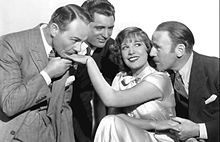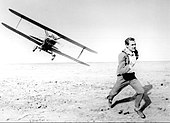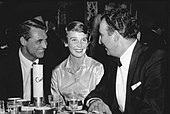Cary Grant
Grant initially appeared in crime films and dramas, such as Blonde Venus (1932) and She Done Him Wrong (1933), but later gained renown for his performances in romantic screwball comedies such as The Awful Truth (1937), Bringing Up Baby (1938), His Girl Friday (1940), and The Philadelphia Story (1940).
[9] Other well-known films in which he starred in this period were the adventure Gunga Din (1939), the dark comedy Arsenic and Old Lace (1944), and the dramas Only Angels Have Wings (1939), Penny Serenade (1941), and None but the Lonely Heart (1944), the latter two for which he was nominated for the Academy Award for Best Actor.
[21] She occasionally took him to the cinema, where he enjoyed the performances of Charlie Chaplin, Chester Conklin, Fatty Arbuckle, Ford Sterling, Mack Swain, and Broncho Billy Anderson.
[42] He began hanging around backstage at the theatre at every opportunity,[38] and volunteered for work in the summer as a messenger boy and guide at the military docks in Southampton, to escape the unhappiness of his home life.
Grant became a part of the vaudeville circuit and began touring, performing in places such as St. Louis, Missouri, Cleveland, and Milwaukee,[54] and he decided to stay in the US with several of the other members when the rest of the troupe returned to Britain.
[54] Learning of his acrobatic experience, Tilyou hired him to work as a stilt-walker and attract large crowds on the newly opened Coney Island Boardwalk, wearing a bright greatcoat and a sandwich board that advertised the amusement park.
[67] J. J. Shubert cast him in a small role as a Spaniard opposite Jeanette MacDonald in the French risqué comedy Boom-Boom at the Casino Theater on Broadway, which premiered on January 28, 1929, ten days after his 25th birthday.
[72] Grant found it difficult forming relationships with women, remarking that he "never seemed able to fully communicate with them" even after many years "surrounded by all sorts of attractive girls" in the theater, on the road, and in New York.
[73] His unemployment was short-lived, however; impresario William B. Friedlander offered him the romantic lead in his musical Nikki, and Grant starred opposite Fay Wray as a soldier in post-World War I France.
[88] Grant disliked his role and threatened to leave Hollywood,[89] but to his surprise a critic from Variety praised his performance, and thought that he looked like a "potential femme rave".
[107] A string of financially unsuccessful films followed, including roles as a president of a company who is sued for knocking down a boy in an accident in Born to Be Bad (1934) for 20th Century Fox,[n] a cosmetic surgeon in Kiss and Make-Up (1934),[109] and a blinded pilot opposite Myrna Loy in Wings in the Dark (1935).
Critical and commercial success with Suzy later that year in which he played a French airman opposite Jean Harlow and Franchot Tone, led to him signing joint contracts with RKO and Columbia Pictures, enabling him to choose the stories that he felt suited his acting style.
[121] In 1937, Grant began the first film under his contract with Columbia Pictures, When You're in Love, portraying a wealthy American artist who eventually woos a famous opera singer (Grace Moore).
[157] Film historian David Thomson wrote that "the wrong man got the Oscar" for The Philadelphia Story and that "Grant got better performances out of Hepburn than (her long-time companion) Spencer Tracy ever managed.
[163] Hitchcock later stated that he thought the conventional happy ending of the film (with the wife discovering her husband is innocent rather than his being guilty and she letting him kill her with a glass of poisoned milk) "a complete mistake because of making that story with Cary Grant.
[171] The commercially successful submarine war film Destination Tokyo (1943) was shot in just six weeks in September and October, which left him exhausted;[172] the reviewer from Newsweek thought it was one of the finest performances of his career.
[173] In 1944, Grant starred alongside Priscilla Lane, Raymond Massey and Peter Lorre,[174] in Frank Capra's dark comedy Arsenic and Old Lace, playing the manic Mortimer Brewster, who belongs to a bizarre family that includes two murderous aunts and an uncle claiming to be President Teddy Roosevelt.
[177] That year he received his second Oscar nomination for a role, opposite Ethel Barrymore and Barry Fitzgerald in the Clifford Odets-directed film None but the Lonely Heart, set in London during the Depression.
[178] Late in the year he featured in the CBS Radio series Suspense, playing a tormented character who hysterically discovers that his amnesia has affected the masculine order in society in The Black Curtain.
[199][200] His roles as a top brain surgeon who is caught in the middle of a bitter revolution in a Latin American country in Crisis,[201] and as a medical-school professor and orchestra conductor opposite Jeanne Crain in People Will Talk were poorly received.
[225] Grant received his first of five Golden Globe Award for Best Actor – Motion Picture Musical or Comedy nominations for his performance and finished the year as the most popular film star at the box office.
[250][251][252] In 1964, Grant changed from his typically suave, distinguished screen persona to play a grizzled beachcomber who is coerced into serving as a coastwatcher on an uninhabited island in the World War II romantic comedy Father Goose.
[213] Morecambe and Stirling claim that Grant had also expressed an interest in appearing in A Touch of Class (1973), The Verdict (1982), and a film adaptation of William Goldman's 1983 book about screenwriting, Adventures in the Screen Trade.
[141] In the 1940s, Grant and Barbara Hutton invested heavily in real estate development in Acapulco at a time when it was little more than a fishing village,[280] and teamed up with Richard Widmark, Roy Rogers, and Red Skelton to buy a hotel there.
[293] He was immaculate in his personal grooming, and Edith Head, the renowned Hollywood costume designer, appreciated his "meticulous" attention to detail and considered him to have had the greatest fashion sense of any actor she had worked with.
[355] Grant supported Thomas Dewey in the 1944 United States presidential election, appearing at a rally at the Los Angeles Coliseum after the New York governor won the Republican nomination.
[382][383] Alfred Hitchcock thought that Grant was very effective in darker roles, with a mysterious, dangerous quality, remarking that "there is a frightening side to Cary that no one can quite put their finger on".
'"[385] No other man seemed so classless and self-assured ... at ease with the romantic as the comic ... aged so well and with such fine style ... in short, played the part so well: Cary Grant made men seem like a good idea.
In July 1976, Betty Ford invited him to attend the Bicentennial dinner for Queen Elizabeth II at the White House and to give a speech introducing her at the Republican National Convention in Kansas City the following month.
[404] In November 2024, a Historic England national blue plaque was unveiled on his childhood home at 50 Berkeley Road, Bishopston, Bristol, where he lived from about age four to six, by Heritage Minister Sir Chris Bryant.





















